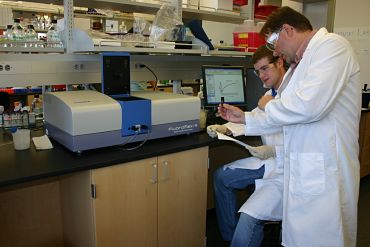J. Craig Venter, PhD, the pioneering biologist who led the first team to sequence the human genome, received a State University of New York Honorary Doctorate in Science at the University at Buffalo on Sept. 20. The honorary degree was conferred on him at a ceremony that followed the grand opening of UB’s Clinical and Translational Research Center in the joint UB-Kaleida Health building in downtown Buffalo.
UB President Satish K. Triapthi called Venter “one of the 21st century’s most influential scientists and widely regarded as the world’s foremost leader in the field of genetic research.” He said he couldn’t think of a more fitting individual to honor on the occasion of the CTRC opening.
The degree was conferred on Venter by Angelo Fatta, UB Foundation board of directors chair, and SUNY Trustee Eunice Lewin.
Venter, a former UB and Roswell Park Cancer Institute scientist, developed a revolutionary strategy for rapid gene discovery while working at the National Institutes of Health. He later founded The Institute for Genomic Research and, in 1995, he and his team decoded the genome of the first free-living organism. At Celera Genomics, which he founded in 1998, Venter sequenced the human genome using new tools and techniques he and his team developed. The successful completion of this research culminated with the February 2001 publication of the human genome in the journal Science.
Speaking before the audience that gathered in the fifth floor atrium of the CTRC, Venter expressed his honest admiration for UB’s newest research facility.
“I’m actually jealous,” he said, after accepting the SUNY honorary degree. “This is some of the most beautiful lab space I’ve seen and the views are always improving.” Venter then described his newest building, now under construction on the University of California San Diego campus, which, he conceded, will have even better views because it is located right next to the Pacific Ocean.
In addition to the CTRC’s physical assets, Venter praised UB and Buffalo for committing to the creation of a life sciences economy. “I’m a strong believer that the future does rest in a bioeconomy,” he said.
Venter also gave an update on genomics, describing the massive amounts of digital information that the research has produced and the challenge caused by this “digitizing of biology.” While the mammalian genome has largely been completed, he said, there is plenty of genetic diversity on the planet that has yet to be discovered.
“By sequencing the microbiome, we find we are not alone,” he said. “In addition to the 2 million human genes we have, each of us also contains about 10 million additional microbe genes. We live in a microbial world; we are visitors here.”
He and his colleagues are also looking at the vast genetic diversity in the ocean. “Every time we take a sample of seawater, we see between 1 and 3 million genes that haven’t been seen before,” he said.
While noting that the idea that it’s possible to sequence your own genome for about $1,000 may be an overstatement, he said that personalized medicine based on a patient’s genetic information “will be a standard part of medicine within a few years.”
Venter is founder and president of the J. Craig Venter Institute, a not-for-profit, research and support organization dedicated to human, microbial, plant and environmental genomic research, the exploration of social and ethical issues in genomics, and alternative energy solutions through genomics. He and his team continue to blaze new trails in genomics research and have published numerous important papers covering such areas as the first complete diploid human genome, environmental genomics and synthetic genomics.
Venter also is founder and chief executive officer of the company Synthetic Genomics Inc., a privately held company commercializing genomic advances.
Ellen Goldbaum; goldbaum@


![[ photograph ]](http://www.buffalo.edu/news/thumbnails/J-Craig-Venter-UB.jpg)




















![[ photograph ]](http://www.buffalo.edu/news/thumbnails/WhiteCoatCeremony.jpg)



![[ photograph ]](http://www.buffalo.edu/news/thumbnails/Anne-Curtis-11.jpg)







![[ photograph ]](http://www.buffalo.edu/news/thumbnails/talal_andrew.jpg)
